Text
Shin Megami Tensei review
Upon the release of the SNES, Atlus, whose Megami Tensei games on the NES were already among the most well designed and memorable RPGs on the console, decided to take the foundation these games built even further. Slapping a “Shin” onto the title and fully distancing themselves from the original Digital Devil Story license, though keeping concepts like the COMP and Demon Summoning Program, the original Shin Megami Tensei, though still influenced heavily by Megami Tensei II, is the game that officially defined the identity of the franchise, becoming one of the most distinctive and influential games on the console. Today, we’re gonna take a look at just what makes this game so special. The version I played was the GBA version, using a patch that ports the official translation from the now defunct iOS version (thanks a lot, Atlus). Note that there will be heavy spoilers throughout this review, so those who wish to keep the story unspoiled, you have been warned.

Story:
Unlike Megami Tensei II, which had loose, but existent story ties to its predecessor, Shin Megami Tensei’s story and setting is a total clean slate. In the year 199X, an unremarkable teenager named Kazuya (note that I’m using the names from Shin Megami Tensei Character Profile: Steven Report I, effectively the closest thing to a source of canon names) begins to have odd dreams that appear to be shared with other people, those being Yuji, a noble and kind, though slightly awkward young man, Takeshi, an abrasive, vindictive, and power hungry delinquent, Yuriko, a mysterious woman who claims to be Kazuya’s eternal partner, and Yuka, a young woman with strange magical abilities who seems particularly tied to Kazuya. In the middle of all this, Kazuya begins to receive messages from a mysterious man named Stephen, warning that ancient demons from the Expanse are invading the human world, intent on annihilating humanity, and that the only hope of combating them is the Demon Summoning Program he invented, allowing one to communicate with and command these same demons.

Just as Stephen warns, demons begin appearing throughout Japan, and chaos rapidly overtakes the country, with a JSDF commander named Gotou using the situation to launch a coup and instate martial law, causing the American military to move in, intent on restoring order. Attempting to work through the madness that his life has become, Kazuya meets up with Yuji and Takeshi, who have similarly found themselves directly involved, allies with a resistance led by Yuka intent on keeping Gotou or the American military from destroying the country in their struggle, and discover that Yuriko is an agent working for Gotou. Eventually, Ambassador Thorman, the commander of the American forces in Japan, is revealed to be Thor in disguise, a high ranking agent of God working to bring about the Millennium Kingdom, a plan to bring about an eternal paradise for God’s followers, at the cost of the lives of all who do not worship Him.

In an attempt to rid Japan of the demons, Thor has a cluster of ICBMs launched at Tokyo, and with no other way to escape, Yuka is forced to send Kazuya, Yuji, and Takeshi to the Diamond Realm, a section of the Expanse ruled over by En no Ozuno, in order to save their lives. After escaping from the Diamond Realm, the trio discover that thirty years have passed in the time they’ve been away, that demons continue to infest the ruins of Tokyo, and that the remaining human population has been reduced to taking shelter within the ruins of Tokyo’s wards, with only two cults holding any significant power: the Messians, devout followers of God who attempt to provide charitable services to the wasteland, yet ultimately wish to continue the plan to bring about the Millennium Kingdom at any cost, through the creation of the Basilica, an enormous cathedral that will ultimately be used to summon God Himself, and the Gaeans, followers of the fallen angel Lucifer who seek to prevent the creation of the Millennium Kingdom and restore the old gods that God once banished to the Expanse to power, yet ultimately prove to be obsessed with power above all else, happily oppressing anyone weaker than themselves and resisting any attempts to build a proper society.

Confronted with the seemingly hopeless nature of the wasteland, and the lack of obvious other powers besides these two extremist groups, Kazuya’s group begins to fracture, with Takeshi’s lust for power driving him to discard his humanity and ally with the Gaeans, while Yuji’s kind, yet naive nature causes him to become taken in by the Messians’ stated goals, while failing to see the sinister forces that drive them. In the end, Kazuya is forced to make a decision: ally with the Messians, and bring about a peaceful, lawful society for those who believe in God’s salvation, at the exclusion of all others, ally with the Gaeans and create a world a truly chaotic and free world for the strongest of men and demons, or, against all odds, take a neutral stance, attempting to keep law and chaos in balance, at the cost of making enemies of both factions and risking becoming an extremist little different from them.

To cut to the chase, a very large part of what made SMT1 so notable when it came out was the sheer bleakness and complexity of its setting and writing. What certainly could have been a straightforward story of good versus evil is instead a tale of the dangers of ideological extremism, and how any cause, regardless of its intentions, will only cause more harm than good if it does not know how to moderate itself. While the different subseries of the franchise tend to prefer their own messages, and the later games in the series usually pick one specific faction to theme their stories around, for the most part, this is the foundation later games would follow. Law and Chaos, despite both having their fair points, are simply too dangerous to trust with humanity’s future, and Neutrality, even if not good, at least removes the most dangerous elements from the world. While it does draw from Megami Tensei II’s plot quite a bit, and frankly has gotten more than a bit repetitive over the decades, it’s still very impressive for something from a 1992 game, and even more so considering plenty of games afterwards were, and still are, more than happy with binary, blatant good and evil morality systems. The cast also set many standards for the series, such as the general personalities of the Law and Chaos representatives, and the recurring character of Stephen, the inexplicably ageless scientist who totally isn’t based on Stephen Hawking and provides you with COMP upgrades throughout the game. It also gave some more distinct identities to certain demons, such as Belial and Nebiros being the caretakers of Alice, who makes her debut her as well, and the four archangels, Uriel, Raphael, Gabriel, and Michael, being God’s highest ranked agents, though there are a few wonky things, like demons like Thor, Odin, and freaking Loki being Law aligned.

That said, while it’s probably fairer to them than some other games in the series, the portrayal of the factions is still far from perfectly balanced. While the Law faction is actually pretty well written, with a decent amount of good actions and intentions that almost make them seem appealing, contrasted by the brutal methods they employ to achieve their ultimate goals that surpass what Chaos ever manages, Chaos does not fair nearly as well. Besides Takeshi, who’s still a much more abrasive, petty, and violent character than Yuji, and, if you’re feeling generous, Yuriko, there is no Chaos aligned character who comes off as even somewhat decent. Yama, who’s taken it upon himself to judge the crimes of humanity, and claims that the use of the COMP to control demons is akin to slavery? Gladly lets you go free when Chaos aligned, showing that “crimes” are only worth punishing when they aren’t done to further his cause. The various endgame bosses like Surt, Astaroth, Arioch, and Asura, who claim to stand for freedom and fight against the suppression of emotion that God desires? Declare you a mindless puppet and try to kill you for willingly siding with Law or Neutrality, bitterly refusing to accept their own defeats afterwards, showing that they only respect the freedom and power of those who choose to benefit them. Even Lucifer, who appears a few times throughout the game in the guise of Louise Cypher, who usually comes off as at least somewhat reasonable and sympathetic? Repeatedly tries to lure you into getting killed, just for not explicitly siding with him. Obviously, the other members and bosses of Law are just as hypocritical and manipulative in many ways, but the fact that even the regular, random NPC Gaeans vocally stand for destruction and the violent oppression of others, with nothing to indicate they really intend on anything beyond that, makes Chaos come off as the blatantly evil faction of the bunch, way more than was probably intended.

This also just ties into a bigger overall problem with the story, namely that it’s just way too dark and depressing for its own good. While focusing both on a present day and post apocalyptic setting is actually pretty unique for the series, more than anything, it just rubs in how much the characters lose over the course of the game. Allies and loved ones die, vanish, or leave you for the sake of their own goals, and sensible people appear less and less the deeper you get into the game, conventional morality nearly totally stamped out by the extremists’ pursuit of their goals. Additionally, it ties into another big problem I have with the alignment system, namely that the story barely changes before the endgame, no matter who you choose to align with. Ally with Thor and kill Gotou, the source of the demons infesting Tokyo and swearing allegiance to God? He nukes Tokyo anyway, and leaves you for dead for good measure, for no apparent reason. Help Echidna, who seeks to destroy the Basilica entirely, by killing the angel Aniel? She doesn’t go through with it in the end, making that choice completely pointless for a pure story standpoint. While obviously technical limitations, and the many constraints of storytelling, mean that only so much variation is possible, it also means that no matter what you try to do, the world ends up in an absolutely horrible state, to the point that the Neutral route doesn’t really accomplish anything besides keeping anyone else from winning. It’s more than enough to kill any real investment in the story. That said, while it does fall flat in places, the story of SMT1 still deserves credit for what it does accomplish, and it does manage to be a properly harrowing experience.

Gameplay:
The basic gameplay of SMT1 is pretty similar to that of Megami Tensei I and II, and since I’ve written reviews of them, which you can read here and here, I won’t go into a ton of detail on it. The bulk of the gameplay is first person exploration, in the style of Wizardry, with a world map that you traverse in between locations. You have six party slots total, with demons being able to occupy three of these slots at a time, later upgraded to four, and the methods of acquiring demons is either recruiting them after encountering them on the world map or in other areas, or fusing two or three of them into a new demon, as demons cannot level up or use equipment. Summoning demons requires money, and keeping them summoned outside of the world map requires magnetite, with demons taking damaged when magnetite runs out. Your human party members can equip both melee weapons and guns, and use either to attack in battle, and attacking generally consists of wildly swinging at whichever enemy the AI decides to target, which is pretty annoying when enemies appear in large numbers. It’s very standard early SMT fare, and frankly, it’s not very interesting. Not busted like some combat systems, but very far from being one of my favorites.

That said, SMT1 does make some notable improvements and additions compared to the older games, some of which are unfortunately only present in the PSX and GBA versions. The party system has been altered to be more akin to Wizardry, with the first three slots representing the front row, and the latter three slots representing the back row, with whoever is in the back row taking less damage from physical attacks. Demon abilities are now clearly divided between magic and extra abilities, the latter of which take the form of attacks like fire breath, group hitting physical attacks, or charging, and are now freely selectable to use in battle, unlike earlier games, where the use of them was completely random. Stats have undergone a slight tweak, with there now being six in total instead of five: strength, which influences the power of physical attacks, intelligence, which influences max MP and magic defense, magic, which influences magic attack, with both of these combined influencing the rate at which a character learns spells, vitality, which influences defense and the maximum HP of a character, agility, which influences the speed, accuracy, evasion, and defense of a character, and luck, which influences miscellaneous elements the critical hit rate or chance to ambush enemy demons. The mechanics of guns have also been changed, as besides the properties of the guns themselves, which have different potential target amounts and base damage, they also require bullets to work, which, alongside differing damage values of their own, can also come with special effects, namely inflicting status ailments like sleep or stone.
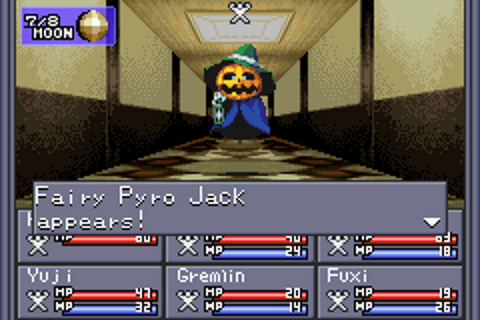
Compared to MT1 and 2, however, where every stat was useful to level for both human party members, the changes to stats here encourages much more specialization. Magic is completely worthless to Kazuya, as intelligence is what helps with demon negotiation, and luck is really only useful on him. Additionally, while melee weapons do end up stronger by the end, for the vast majority of the game, you’ll likely only find yourself using guns to attack, except in cases where it’s simply not effective. Guns that can target multiple enemies are pretty easy to come by, the status effects they deal can be devastating, and, most importantly, it’s extremely difficult to come across melee weapons most of the time. Knife stores, your initial source of melee weapons, completely vanish after the apocalypse, and the only source besides a few weapons from scripted events or treasure chests are from enemy drops, which aren’t frequent enough to rely on. Therefore, agility ends up way more useful than strength before the endgame. Ironically, this is the exact opposite of MT2′s situation, where guns were near useless past the early game, even considering the even lower frequency of weapon drops.

Since I’ve mentioned demon negotiation, that’s something that’s gotten a large overhaul. In earlier games, it was a simple affair, just a little menu of choices to either try to bribe the demon to your side, persuade or soothe them to increase your chances of success, or attempt to threaten them into joining. Here, however, things have become much more complex. Instead of instantly being presented with a menu like before, you’re now forced to persuade whatever demon you’ve encountered to even hear you out in the first place. Before beginning your attempts at negotiation, you can choose to take either a friendly tone, or a threatening tone, with each leading to different sorts of conversations. Demons also have several different possibly personalities, though each specific demon type will always have the same personality, meaning that Shuten Doji, for instance, will always have a “grumpy old man” personality, while Rangda will always have a “haughty noblewoman” personality. While there are certain paths that always seem to end in failure, and ones that have greater chances of success, and you can learn what answers to take for the most consistent results overtime, unfortunately, it still just comes down to pure RNG in the end, with demons sometimes aggressively fighting off all your attempts to please them. Once you do get through to them, you can either ask them for money, magnetite, request that they leave, or ask them to join you, at the cost of resources like money, magnetite, healing items, and gemstones. All of these tend to give better results if you really manage to make a demon like you beforehand, tending to give larger amounts of money and magnetite, along with usually requiring less resources to get them to join you. You can also threaten them to join you for free if you take the intimidating route, but this usually requires you to be several dozens of levels above your target to have even a chance to work. While it’s a lot more interesting than the old system, it’s also much, much more frustrating to deal with.
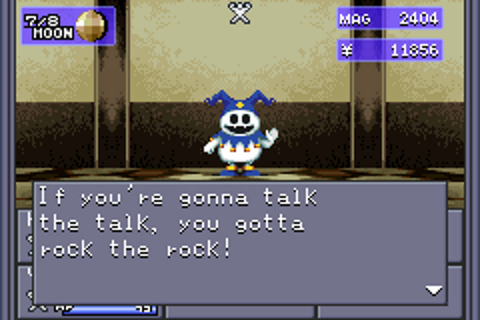
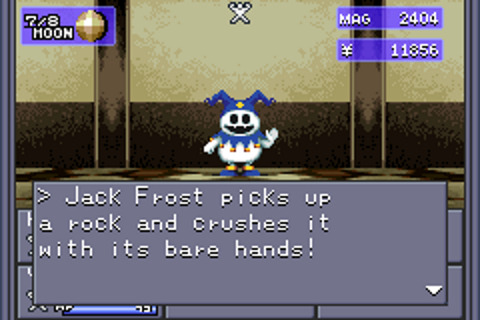
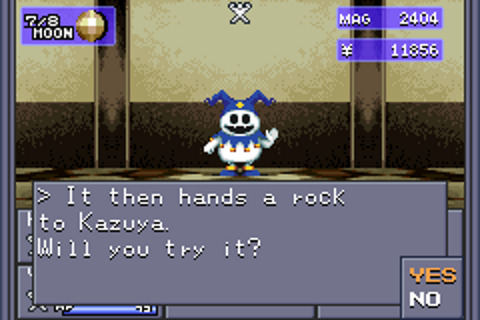
SMT1 also made vast improvements to the amount of demons that are recruitable, thanks to the overhaul of the alignment system. In the earlier games, alignment only went so far as evil, neutral, and good, with evil demons being completely unrecruitable, neutral demons being recruitable through negotiation or fusion, and good demons only being acquirable through fusion, only showing up as enemies in a few very specific instances between both games. In SMT1, however, moral alignment was changed to dark, neutral, and light. Neutral demons work the same, as do light demons, for the most part, only being obtainable through fusion, as they simply refuse to listen to you even in the rare instances you encounter them as enemies. What’s significantly changed is dark demons, as while they still can’t be obtained through negotiation, they can now be obtained through fusion, with only a few exceptions among them all, like the Undead race, the Fiends, who make their debut in this game, and most of the Foul face. Therefore, while there’s only 255 demons in the game, not counting bosses, compared to MT1′s 142 and MT2′s 250 demons, 237 are obtainable for your party, compared to 65 in MT1 and 129 in MT2, which, needless to say, is a gigantic step forward.
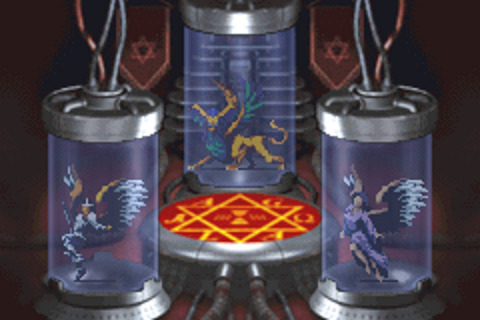
But of course, the far more significant change to alignment is the addition of Law, Chaos, and Neutral alignments to the mix. Every demon has an ideological alignment along with their moral alignment, with the vast majority belonging to either Law or Chaos. Through the player’s actions, Kazuya’s own alignment can be changed, either through big story events, such as agreeing to kill Thor for Gotou, or vice versa, or smaller actions, like choosing to use the services of Messian, Gaean, or Neutral healing ashrams. While, as I said, the overall story doesn’t change much depending on your alignment, it absolutely changes your experience in terms of gameplay. Not only do you fight different bosses depending on your alignment, with a Neutral playthrough having the potential to fight every single one of them, but the demons you can use, and the ways you can acquire them, changes too. Law aligned characters are restricted to Law and Neutral demons, as Chaos demons reject all attempts to recruit them, and while they can be fused, they aren’t useable in combat. This applies vice versa in the case of Chaos, while Neutral characters can use demons of any alignment. Ashrams that match your alignment cost less to use, so you’ll find yourself hanging around areas with Ashrams that match you, and the differences in stats and abilities that each race tends to have makes for very different parties. It doesn’t mean you can completely ignore one faction’s demons, as more powerful races like Deities and Tenmas very often require demons of the opposite alignment to fuse, but it’s impressive just how many ways your alignment affects the way you play the game, to a degree many other games can’t match.
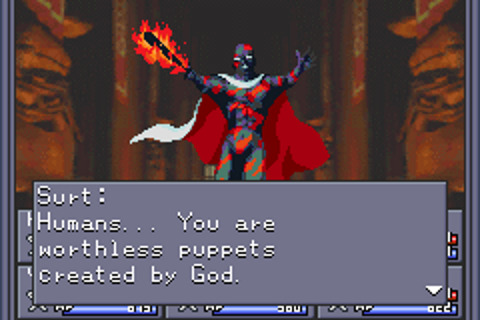
Fusion has also been tweaked a bit. Along with retaining double, triple, and special fusion, though the latter has been reduced to fusing Cherub, Throne, and Dominion for Uriel and Barong and Rangda for Shiva, marking the debut of that latter method, there’s also a new type of fusion called sword fusion, involving combining a specific couple of special swords with specific demons to make stronger one. Knowledge of this mechanic and what you can use with it can easily get you the Hinokagutsuchi, one of the strongest weapons in the game, and the strongest one you can reasonably acquire, as soon as you obtain its base form, the Kusanagi, but nothing in the game ever indicates what demons work with it, meaning that for those playing blind, it’s either an extreme form of trial and error, or a completely ignored mechanic. Human enemies that can be recruited like demons have also been added, with the special ability of producing a random result when fused with any demon. You can see this in advance, so you’re not just shooting yourself in the foot, and often it’ll result in something weaker than you need, but there are times these random results can save you a lot of effort. This game is also the debut of the system of unlocking boss demons for fusion by defeating them, though it’s really inconsistent. Demons like Vishnu and the Archangels can indeed only be fused by defeating them, but Yama, an optional boss assuming you’re either Chaos or Neutral aligned, is fuseable no matter what, even though Niou, a boss you also fight if you choose to fight Yama, is locked out of fusing otherwise. By contrast, Ravana, a story boss for Law and Neutral, is also only fuseable after beating him, but Indrajit, a separate boss who fights you immediately after Ravana, is fuseable well beforehand. These inconsistencies can be pretty maddening, and the lack of anything in the game to indicate this mechanic even exists makes it even worse.

Frankly, maddening is the perfect word to describe this game. All things considered, it’s easier and less punishing than MT1 and 2 in many ways. The effectiveness of guns makes dealing with hordes of enemies much easier, and light demons are generally very useful. It’s just that there’s so many frustrating elements throughout. The encounter rate, while more than tolerable early on, becomes so much worse after the apocalypse, with encounters happening on the world map literally every few steps. Sometimes, random encounters will actually turn out to be two or three encounters in a row, as in, enemies pop in immediately afterwards without even leaving the battle screen. Equipment is so absurdly expensive that there’s almost no way to afford it besides negotiating money out of random encounters for hours on end. While some dungeons can go on a little long, but are overall tolerable, the final dungeon, the Basilica, is a sixteen floor behemoth that can literally eat up an entire day all by itself, all while the most obnoxious track in the game plays over it. It’s the worst final dungeon I’ve ever gone through in a game, and having to do so three separate times nearly destroyed my sanity. The game also really doesn’t like to make it clear what you’re supposed to do at times, with a few easily forgotten NPCs giving you hints at best. For example, the first location you’re supposed to go through after the apocalypse, Shinjuku, requires you to talk to a specific NPC hidden in a side area you may well not even know about before you can challenge its boss, despite him not telling you anything more than the other NPCs scattered around the area. It’s not terrible, since there’s no encounters within Shinjuku at this time, but it’s needlessly a cryptic moment if you’re not intent on mapping out the whole area and speaking to absolutely everyone. There’s also just tons of moments of obscurity that you’d never figure out without looking up a guide. Beyond sword fusion, there’s sidequests like an optional boss, Kazfiel, who can be fought in Tokyo Tower as a Chaos or Neutral character after the Aniel and Echidna incidents, but only if you haven’t visited it beforehand, which is a pointlessly cruel move when it’s an out of the way area most likely wouldn’t even find without trying to explore on their own. There’s also buildings that get rebuilt and offer you a choice of three items late in the game, but said items get swapped out for rare equipment if you visit during specific moon phases. Obviously, the game never even hints that this could happen, or what phases to visit each building during. The best set of Neutral armor can be found on the world map by visiting the mansions of the Four Devas after meeting Taira no Masakado, himself an optional, hidden NPC, but nothing in the game indicates this process could lead to anything. The crowning moment of awfulness, however, goes to the mechanics of the Fiends. In certain areas, specific tiles with trigger forced fights. Most of the time, it’s a generic enemy you could encounter elsewhere in the area, but rarely, it’ll be a stronger and sometimes exclusive enemy, such as Bigfoot or Cyak, and even more rarely, as in, a 1/256 chance, you’ll encounter one of the three Fiends, Pale Rider, Daisoujou, and David. These enemies give massive amounts of experience, and have a chance to drop some of the most powerful weapons in the game, but said drop rate is apparently also 1/256, which translates to something that would destroy your life if you really wanted it.

And really, there’s no reason to destroy your life over them anyway, because the game is already pretty damn broken, in your favor. For a basic example, the Zio line of spells has a very high chance of electrocuting anyone hit by them, causing them to skip their turn if hit before they can act. Yuka learns Zio spells, and you’ll likely be leveling her agility quite high anyway. Do the math. Assuming you can get it, which isn’t difficult to do once you know what demons you need for it, the Hinokagutsuchi is disgusting broken for the point at which you can make it, and remains so even up to the end of the game. And while the sheer power of most endgame demons can be excused, since you have to make them yourself, there’s two examples that absolutely cannot. On the Chaos route, you outright directed in an unmissable encounter towards Beelzebub, one of the absolute strongest demons in the game, who proceeds to join you for free, regardless of your level. That’s bad enough, but the Law route feels like the developers just stopped caring by the end. Not only are you directed to recruit Vishnu, the actual best demon, for free, but you are required to recruit Uriel, Raphael, and Gabriel as well, all of whom are also some of the absolute best demons in the game. Sure, you have to give them up to access Asura, the final boss of Law, but nothing’s stopping you from sweeping the entire rest of the dungeon with this team before them. Even without these free boons, you’ll be strong enough by the end of the game that most encounters are just annoyances, and the bosses give tons of EXP, without being nearly strong enough to justify it. While it’s nice that the game doesn’t try to be impossible, it honestly just makes the experience even more boring by the end. Most bosses boil down to Yuka casting Zionga until either she runs out of MP or the boss dies, and most bosses can do so much damage that it almost feels like it’s intended. All of these elements come together to make one of the most draining gaming experiences I’ve ever gone through, to the point I had to take multi month long breaks inbetween playthroughs, not helped by just how long each playthrough takes.
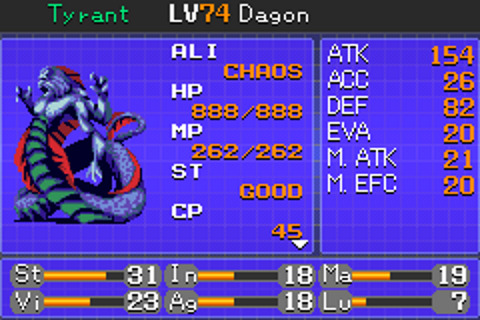
Finally, to touch on some of the features exclusive to the ports of this game, the most convenient addition is being able to access the automap just by pressing the L button, when originally, the feature was kept behind several menus, which was horrible. That alone justifies not playing the SNES version to me. Additionally, a colored bar is present near the bottom of the screen during exploration that indicates how likely you are to get into an encounter, turning more and more red the closer you are to an encounter. That doesn’t mean it’s always accurate, as you can easily get into an encounter a single step after getting out of one, but it does help. Finally, and most notably, is the addition of A-Mode DDS, a sort of extras menu. Not only does it contain multiplayer functionality that I barely understand, but it also gives access to a demon dictionary, which allows you to see the stats of an demon you’ve encountered across any of your playthroughs, as well as read upon on their lore, like later Demon Compendiums in the series. There’s also the Visionary, a movie gallery of sort that shows extra cutscenes made specifically for the GBA port. To watch these, however, special key items need to be found within the main game. These are shared across all save files, and a good chunk of them are dropped by bosses, but many others are found in what are otherwise empty rooms and areas in earlier ports, appear only after certain events are triggered, or only become available after completing the game, possibly with a specific route, at that. The optimal route order for acquiring them all is Law, then Chaos, then ending with Neutral. Honestly, for the effort you have to put in to get them all, they unfortunately don’t add a ton. Some of them help clear up tiny questions left unanswered otherwise, or give additional characterization to the cast or bosses, but there’s nothing super important there, and others are just plain filler. There’s nothing wrong with just looking up a video of them if you don’t want to go through the effort of getting them all. Finally, beating the Chaos route specifically unlocks the Demon Bank at the Cathedral of Shadows, the location where demons are fused, which allows you to store a number of demons to take out whenever you want. While you can’t use this to get ahold of multiple copies of one demon, it’s actually very helpful, as you’re limited to holding a pretty small number of demons for a good chunk of the game, and saving a demon you could use for fusing something else later helps a ton. It’s definitely one of the most helpful additions, though why Chaos specifically unlocks it is beyond me. Overall, it’s not wrong to call SMT1′s gameplay dated, because it is in many, many ways. While it does take some important steps forward, it also retains a lot of the worst elements of RPGs from this era, and I don’t blame most people from wanting to avoid dealing with it all.

Graphics:
The SNES version of SMT1 also drew heavily from Wizardry in terms of its visuals, by which I mean it looked really, really bad. Both the world map and first person areas looked really bland, with Kazuya’s room, for instance, only having a computer, and otherwise being a bunch of blank walls. Not only was it monotonous, but it often looked extremely unfitting for what the areas were supposed to be. Thankfully, the PSX and GBA versions made massive improvements over this. The world map looks much better, and areas actually look distinct and sensible, with special rooms often having special prerendered backgrounds to represent just what they’re supposed to be. Obviously, the GBA limitations make these look very crunchy at times, but a bit of crunch is still preferable to a bunch of blank, identical walls. It also added a few neat effects, like the camera slowly scrolling upwards upon encountering the bosses within the Basilica, doing a very good job of conveying the sense of scale and importance to them. Sure, the increased saturation of GBA games hurts the atmosphere a bit, but it’s hardly a deal breaker. Plus, the scrolling while moving is much smoother than in the SNES version.

The character sprites, on the other hand, continue to be smudgy, lacking in detail, and overall just, bad. Honestly, I feel like they look the most tolerable in this version. The lower resolution and general crunchiness of the other visuals make them fit in better, while they look terrible in the PSX version, with its fully 3D environments. The demon sprites, on the other hand, are much better. While MT2 was already a big step forward, this was where Kaneko really started getting their designs down. Demons like Michaeal and the other Archangels, Jack Frost, Arahabaki, Beelzebub, or at least his Baal Zebul form, Decarabia, Nebiros, and Abaddon received their iconic designs here, while others like Belial, Cu Chulainn, Shiva, Mara (no, I’m not posting what that, and yes, it looks exactly like you’d expect), and Surt getting designs at least pretty close to what would come later. The sprites in general just look really nice, and while most of them do use the same body templates, plenty actually avoid being pure palette swaps, with Stonka and Rakcharango having their distinguishing eye and demon mark, respectively, which manages to keep them looking distinct. That said, there’s still cases of blatant palette swapping. Barong and Rangda still look the same, Indra is blatantly a swap of Zouchouten, Koumokuten, Jikokuten, and Bishamonten, who are already palette swaps of each other, and so forth. The worst case is with the angels of the Divine race. Angel and Throne look the same, and Power, Virtue, and Dominion are identical as well, something that’s very easy to notice if you upgrade them in a linear order. Archangel’s design, which is otherwise unique among the Divines, get reused for Uriel, Raphael, and Gabriel when they’re in your party, which leaves Cherub as the only one that actually has a unique design. I get that space and technical limitations play a part in this, but it’s hard to ignore. Still, that sums up SMT1′s visuals, a mixed bag with some parts that look great, and some parts that just don’t.

Music:
The SNES version of SMT1 has a very distinctive soundtrack, thanks to just having a very distinct, metallic sort of sound to it that shows up in almost every song. It makes for a very good soundtrack that I love to listen to, with songs like the battle theme, the haunting Law theme, the Cathedral of Shadows’ theme, the theme of the mansions of the four devas, and of course, the Ginza theme sticking out to me. Of course, the GBA’s sound capabilities were far below that of the SNES, and the soundtracks of many SNES to GBA ports came out pretty bad because of it. All things considered, though, I feel like this one is pretty well done in comparison. Definitely not better overall, but most tracks manage to retain their feels, including those that I mentioned above. I’d even say I prefer a few tracks in the GBA version over the SNES version. The Neutral theme, for instance, is downright obnoxious in the SNES version, but is actually pretty calming in the GBA version. Ginza also sounds pretty great, and the level up theme, which was pretty offputting original, sounds more fitting now. I have to commend the porting team, they managed to make convert it all pretty well.

Conclusion:
Overall, would I recommend SMT1 to most people? No. Even to people who like modern mainline SMT, this one is a type of brutal I would not even think of trying to put others through. If you’re really, really curious about how it all started, and have the necessary patience, you might be able to get through it, but seriously, just do yourself a favor and just do a single playthrough as Neutral. There’s not enough else to warrant repeat playthroughs. Still, even if it was miserable for me to go through, it was a hugely ambitious game for its time, and its influence on the series is still evident today, and for that, I can respect that. Till next time.
-Scout
9 notes
·
View notes
Text
I finally gave Eureka Seven: Good Night, Sleep Tight, Young Lovers (aka Pocketful of Rainbows) a watch. What a weird movie. I can’t be totally surprised, since the series had plenty of weird moments, but this was on a whole other level. Still, though, for the most part, I could see what it was going for, and on an overall level, I’m okay with the movie. I wouldn’t rave about it the way I do the original series, but I enjoyed a good deal of things about it. I was very okay with it being an AU movie, just because the series ended so fittingly and conclusively, and as far as AU stories go, it’s so different in so many ways that it actually does feel like you’re watching a whole other set of characters, which made me okay with some of the bigger changes they did to the characters. I might’ve actually been annoyed with them if it was closer to the series than it was, but it established itself as something so very different that I could mostly take it as its own story.
The relationship between Renton and Eureka wasn’t nearly as compelling to me as in the series, but that’d be impossible to achieve in just two hours, and they still had some very good moments, especially around the climax. I also like how it basically works as a much darker take on the first half of the series, and the idea of two youths trying to connect despite the interference of a selfish older generation. The animation was really nice, and the use of different color palettes at different points in the movie was a very neat touch, though I wish there was a lot less reused animation. There was some really good music too. Overall, I thought it was decent, and I’ll probably rewatch it at some point. Maybe my opinion will even grow on it once I do so. As for the animation parts of Eureka Seven, I think this is where I’ll call it. AO and Hi-Evolution don’t really interest me. As far as other things go, though, I’ve still got the manga, and maybe the video games, to go through. I’m actually very excited to read the manga, and I’m definitely gonna start on it soon.
6 notes
·
View notes
Text
As someone who’s only played two or three total, holy crap, I love rhythm games. I’m not that great at them yet, but the feeling of just turning off your brain and demolishing a challenging song just because you’ve instinctively learned how it goes, and only need to pay attention to the screen just to see what buttons you need to hit is one of the most satisfying feelings I’ve had games give me. The feedback loop of gradually getting better at each song and trying them more and more in order to push yourself is so much fun.
Years ago, I only played Theatrhythm Final Fantasy Curtain Call, which, as someone who loves Final Fantasy, is a fantastic game, but recently it’s been Project Mirai DX. Even as someone who’s only dug into Vocaloids on a surface level, I’m loving it. I know it’s supposed to be easier than normal Project Diva games, but I’m totally fine with that. That just makes it easier for me to get into as a newcomer, and it’s still just challenging enough for me to keep me interest with pretty much every song so far. The song selection has been really good for me too. I already have so many songs stuck in my head (Senbonzakura, Romeo & Cinderella, Mousou Sketch, 1925, and Reverse Rainbow the most so far), and some songs having multiple singer options is such a great touch. It adds in a nice bit of variety, and it gives more presence to the other Vocaloids, and as someone who already knows Luka is my favorite, I very much appreciate that. Also, it’s freaking adorable. Basically, I’m loving almost everything about this game, and once I finish it up, I’ll really have to check out Future Tone sometime, even if I’ll probably suck at it.
3 notes
·
View notes
Text
So here’s a really common story: I had a huge Danganronpa phase several years back, before V3 released. I was really hyperfocused over it, and it would just not go away, but then V3 came out, and burned me super hard until I lost basically all of my passion for it. Nothing too innovative there, but I will say, even now, after all that, I have not lost any appreciation for Danganronpa 1. The creativity and comparative seriousness it has towards its premise compared to the others is just something I love. Stuff like the rules the cast establish among themselves, like no leaving their rooms at night, or the complexity in each case usually coming from outside interference. It felt like the other two played their premise a lot straighter, whereas DR1 is pretty much always throwing curveballs every step of the way.
The atmosphere is just so good, too. The settings for DR2 and V3 just felt too bright and wide open for me, but Hope’s Peak always feels cramped, unnerving, and just plain dangerous the whole time. It really feels like there could be something terrible around each corner. And while I do think DR2′s cast is probably better overall, I do appreciate the cast a lot too. There’s definitely a few characters who really didn’t get the kind of time or development they needed, and a few I just plain can’t stand, but I like how nuanced a lot of them are, and they help sell the feeling of being trapped with a bunch of unpredictable weirdos without going too overboard with it. It was just a novel kind of experience that I still respect a lot, and even if I’m never really gonna regain that passion, I don’t regret having that phase, if only because it helped get me into visual novels as a whole.
2 notes
·
View notes
Text
Well, I bought Phantom Breaker Omnia, mostly to play with a friend. I’m really not a fighting game guy normally. The only one I’ve really put any significant investment into is Tekken 7, and I only had my eye on the game at first because of Kurisu and Rimi, but the demo it had last month was actually a ton of fun for me, and convinced me of the game’s other merits. Kurisu and Rimi are now just the cherry on top of everything else instead of the only appeal.
1 note
·
View note
Text
I have some really weird feelings towards the Steins;Gate anime. It’s very, very well made, both as a visual novel adaptation and in its own right, and it totally deserves its reputation, but I can’t really feel much about it as someone who read the VN first and fell in love with Steins;Gate doing so. Instead, I just see all the big and little things that the anime had to change or cut out, whether it be losing the really unique artstyle, or really cutting down on the chapters that make up the second half of the VN. It honestly could have used an extra episode or two just to smooth out the pacing a bit better and include some of the more notable omissions (mainly everything going on during Moeka’s arc).
That said, I’m going to be rewatching it in a bit for the sake of a new series of posts I’m gonna start making, comparing VNs to their anime adaptations, and the things they keep or change, so maybe I’ll start appreciating it more soon.
11 notes
·
View notes
Text
I think the real reason I’m not feeling much towards Chaos;Head NoAH English right now is just because I was literally dying from how excited I was for Robotics;Notes for most of 2020. That’s not something I could handle twice in one lifetime. It’s also probably because I’d been following Committee of Zero’s attempts at a translation ever since they actually started making progress on it, and I’d gotten used to waiting months for anything exciting. Either way, I’m sure the excitement will get insufferable once October actually draws near.
1 note
·
View note
Text
I’m not trying to turn this into an Eureka Seven blog or anything, as much as I’d like to, but I realized last night that Gundam 0080: War in the Pocket’s ED and Eureka Seven’s fourth and last ED have the exact same concept: showing a series of pictures showing a bunch of ordinary people having to adapt and survive in the aftermath of war. The main difference between them is that War in the Pocket’s ED doesn’t actively invoke tragedy in most of its images. They take place from the perspective of children, and they often seem to be taking it all in stride, as part of the whole OVA’s themes and tone. It’s their innocence and lack of understanding that causes it to have such a strong sense of melancholy. The only picture involving anyone from the actual cast is the last one, and it’s only bittersweet in the context of the plot.
youtube
Eureka Seven’s ED is much more straightforward in its imagery. Its pictures are, at their best, heavily bittersweet, and those are in the minority, and several of them feature some of the series’ most important characters, showing just how war affected them, and connects to how they continue to be affected by it even by the time of the series’ proper start. This is also completely in line with Eureka Seven’s themes. Both methods are very, very effective, and it got me wondering whether there’s any other anime OPs or EDs out there with a similar theme to these. I’d certainly be glad to hear about them.
youtube
6 notes
·
View notes
Text
Chaos;Head NoAH English
So yeah, Chaos;Head NoAH is finally, officially getting an English release. It was soft confirmed a few weeks ago, and accidentally confirmed early yesterday, so everyone was just kinda waiting around for an official word about it. I’m certain this is all separate from Phantom Breaker Omnia, which has Rimi as a guest character, releasing soon, but I’m gonna pretend it’s responsible anyway, because it’s a pretty fun game.
So firstly, damn, I was sure this would never actually happen. I’m not one of those fans that spent the 14 years since Chaos;Head first released waiting for something like this, but I still let the mindset of “Chaos;Head NoAH never” get to me. So thank you, Spike Chunsoft, for making this happen. It’s pretty awesome. Also, the steelbook art looks amazing. I love the look Rimi has going on in it.
Of course, it’s not a perfect situation. So far, only a version for the Switch is confirmed, as part of a double pack with Chaos;Child, and while I do own a Switch, I own and played all the rest on PC, and considering NoAH never released on PC to begin with, I’m really worried that’s going to be the only option available. They will, at least, be available for purchase separately, so anyone who already played Chaos;Child doesn’t need to pay extra for that. Furthermore, the Switch version is based on the PS3 version, meaning it’s censored. Normally, with VNs, I admittedly wouldn’t care as much about that with some, but apparently a lot was taken out from some parts because of this, and furthermore, it’s literally a horror VN. Toning that down, especially when it’s an experience that’s so genuinely effective at getting to you, is just missing the point entirely.
I’m sure there’s plenty others who’ll be worried about translation quality and such, but, eh, we’ll see about all that once it’s actually out. All in all, I am happy about this announcement, and excited to finally be able to play it once it’s released. Even if I’m concerned about some parts of it and whether or not they’ll be fixable, either way, I’m sure I’ll manage and enjoy it in the end.
2 notes
·
View notes
Text
A look at: a few Gundam OVAs and movies.
Since I just wrote about Mobile Suit Zeta Gundam and ZZ in my last post here, I figured I’ll just write up a post about the movies and OVAs that come between ZZ and Victory Gundam, cause I can’t contrive a way to talk about them through my “natural” ways. This isn’t a ranking, just straight opinions.
Mobile Suit Gundam: Char’s Counterattack

I enjoyed this quite a bit. Settling Amuro and Char’s rivalry once and for all is a concept that certainly felt worthy of a movie, and they went all out with the budget that afforded them. The animation was very good; seeing the 80′s Gundam series artstyle with actually fluid animation felt very weirdly satisfying, though seeing Bright and Mirai with normally colored eyes disturbed me a bit. The mobile suit designs and action scenes were great, and the climax was genuinely very tense and epic. That said, damn, there were some weird things throughout it, most of which were apparently due to outside factors. Everything starts way too fast, because it’s literally starting from around the middle of the story draft, apparently, Chan was a very random inclusion and really didn’t stand out to me as a character, and not having Sayla involved at all was a huge waste, just for a few examples. Still, though, these only bog it down for me so much. It was still a very exciting and memorable watch, and a good way to end off that saga of the franchise for a while.
Mobile Suit Gundam 0080: War in the Pocket

Absolutely my favorite watch of the franchise so far. I loved the concept of a story just focusing on a bunch of nobodies away from the real action, the three main characters were fantastically developed, and it actually managed to make mobile suit battles just seem plain brutal more than anything else. It looked great, the OP and ED were especially memorable and effective even in a franchise with so many great ones, and David freaking Hayter as Bernie alone convinced me to watch the English dub, whereas everything before and after, I’ve gone with the subs. The rest of the cast did great too, but Hayter was such a perfect choice I just had to gush. More than anything, though, the story was just so effective at what it was trying to do. It was just plain gut wrenching seeing the downward spiral of the second half, and the final episode managed to draw a few tears from me (still way less common than I’d like it to be). This is one thing I’d say to watch even to people who don’t watch Gundam.
Mobile Suit Gundam F91
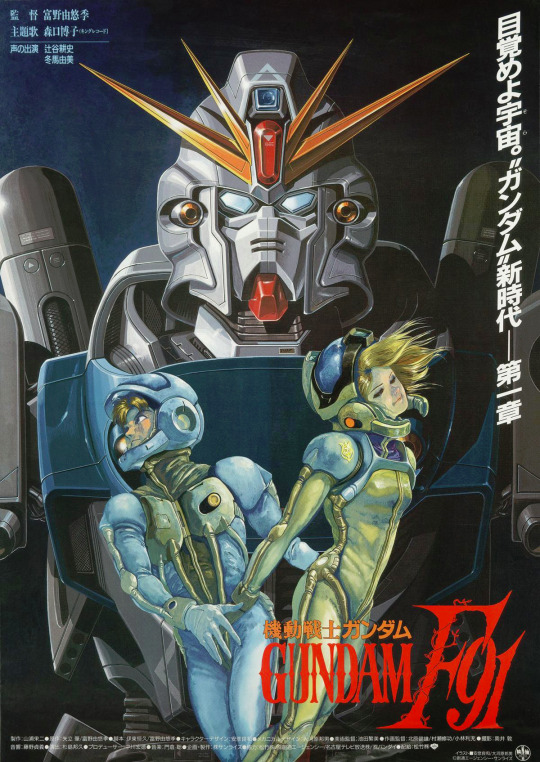
What do you get when you try to turn 13 episodes of a prospective full anime series into a movie that’s not even 2 hours long? One of the most nothing things I’ve ever experienced, apparently. I can’t even say I disliked it, but I didn’t enjoy it nearly enough to say I liked it, either. It just felt like a super watered down rehashing of the original 1979 Gundam series. Protagonist who has to pilot a mobile suit designed by his parent after his colony is attacked, one of the main female characters actually hailing from the enemy faction and being the sibling of one of their resident aces, some lesser pilot who seemed to be an attempt at copying Kai Shiden, the works. All the while it just tosses in tons of characters who barely any time to distinguish themselves and, barring a select few, really don’t have any point to existing. They could have probably done some more interesting things with all this if they had gotten to make it a full series as planned, but instead, it’s just underwhelming.
The new mobile suit designs didn’t really resonate with me, mostly because the goggle heads just looked too weird for my liking, the animation somehow wasn’t as good as Char’s Counterattack, and I’ve already forgotten how most of the action sequences went. There are a few good things, at least. Everything to do with the attack on the colony and the Bugs were genuinely horrifying, Iron Mask was actually pretty memorable, between being a goofy as hell Darth Vader lookalike and actually being surprisingly threatening despite that, with a neat final boss mobile armor that delivered a pretty good climax, and while I don’t remember the actual soundtrack, the vocal songs, Eternal Wind and The time I’m seeing you, have a stranglehold on my soul. I’ve been addicted to them for months, and that’s not looking to change anytime soon. Besides that, uh, I don’t really have anything else to say, except that I really should read Crossbone Gundam one of these days.
Mobile Suit Gundam 0083: Stardust Memory
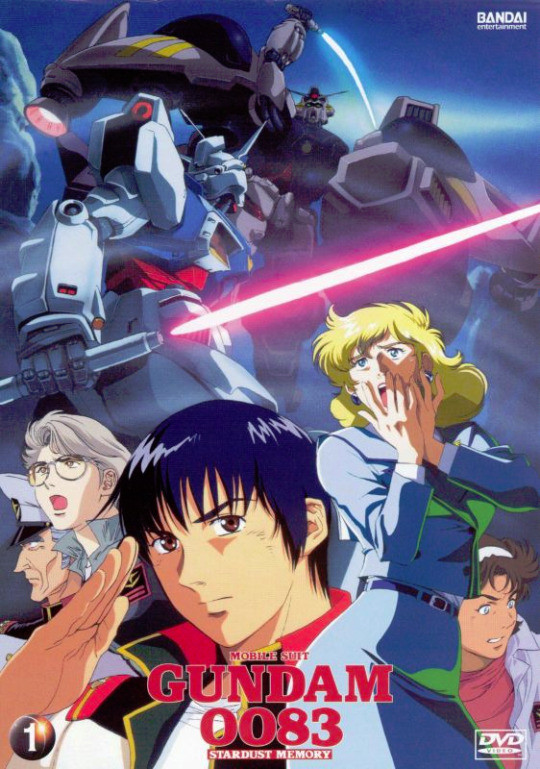
This one honestly just broke my heart. It has so many good things going for it. The animation, mobile suit designs, and general artstyle are fantastic, and it overall has my favorite look of anything in the franchise so far. It has some amazing action scenes, and the fight between Kou and Gato in episode 10 may well be my favorite sequence in any Gundam work so far. The cast, at least as far as the protagonists go, actually has a few pretty likeable characters, and manages to develop Kou pretty well. The music, especially the OPs, is fantastic, and I still start up The Winner and Men of Destiny every once in a while. It’s set to deliver something great, and then the second half comes around, and with it a change of directors, and just like that, it starts squandering things left and right.
War in the Pocket may have mostly focused on Zeon’s characters, but it didn’t nearly go overboard with them compared to the original series. It just showed it as it was: a lot of decent grunts who didn’t personally desire most of the horrors of the One Year War, but were ultimately led by irredeemably evil people. Here, however, it tries so, so hard to make Gato and Delaz seem noble and sympathetic, when their plan, a friggin colony drop, has been shown to be so horrifically destructive that anyone who even tried it in earlier stories instantly cemented themselves as vile at best, whether to other characters, or even to themselves. Needless to say, it falls so flat that I can’t stand either of them as characters. In general, it just idolizes Zeon so much and demonizes the Federation so much that you have to wonder what the point in following a bunch of Federation characters even is. Throw in a horribly contrived love triangle that ruins Nina as a character and a climax that stacks everything in Zeon’s favor so heavily that it really starts to become a drag, and the main feeling left behind after all the really cool action scenes are done is bitterness. Even if the plot had to be a foregone conclusion, there’s much better ways of pulling that off than literally making the protagonists so ineffectual that they could have all died in the first episode, and nothing would have changed in the slightest.
I don’t hate Stardust Memory, and I still appreciate the things it does right. It’s just the things it does wrong piss me off so much that they’re most of what come to mind when I try to think back on it. The good aspects make it worth watching at least once, but goddamn, know what you’re getting into. With that rant out of the way, that’s about all I have to say about these four things. I’ll rip off the bandage and watch Victory Gundam one of theses, but I really don’t need 52 episodes of pure depression right now. Till next time.
-Scout
12 notes
·
View notes
Text
Ranking the 5 anime I’ve recently watched: mecha edition
For a while, I was actually pretty reluctant to try out watching mecha anime, only really touching Tengen Toppa Gurren Lagann and the original Mobile Suit Gundam before. Recently, though, I became inspired to dive deeper into the genre, and after going through a little mini binge of it, I can say with confidence, it’s a pretty great genre. Already, many of the ones I’ve watched have been stylish, very entertaining, and just plain unique experiences, with one of them quickly managing to become my new favorite anime, period. This was actually the hardest ranking I’ve done so far, due to just how much I enjoyed most of the shows here, and since I have a lot to say, let’s just jump right in. As usual, this is absolutely bias city.
5. Mobile Suit Gundam ZZ
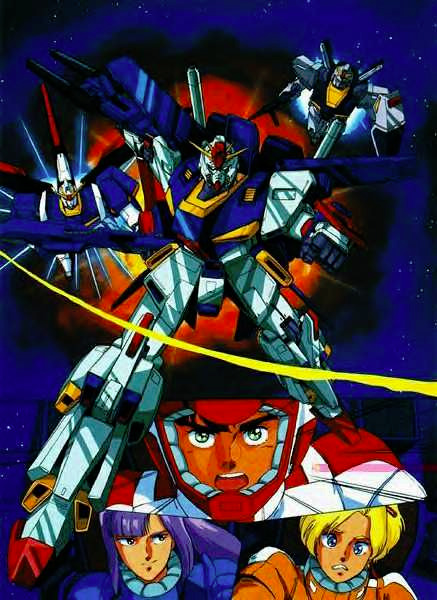
Number of episodes: 47. Language options: subs only (technically an English dub was made, but it’s mostly lost media). Streaming availability: none.
Produced by Sunrise, a name that is going to show up a lot in this post, Mobile Suit Gundam ZZ is the third full Gundam series, the sequel to Mobile Suit Zeta Gundam, and the third series taking place in the Universal Century setting, taking place merely days after Zeta Gundam.
In the year 0088 of the Universal Century, the Anti-Earth Union Group (AEUG), freshly out of a costly victory against the Titans, finds itself faced with yet another opponent: Axis, the remnants of the Principality of Zeon, led by Haman Karn, the supposed regent for Mineva Zabi, the young final heir of the Zabis, the original rulers of Zeon. The Argama, the AEUG carrier ship which proved a key player in the prior Gryps War, limps its way to the decrepit colony of Shangri-La for much needed repairs. While there, Judau Ashta, a young teen who, along with several of his close friends, works as a salvager for a living, attempts to steal the now vacant Zeta Gundam in hopes to provide for his little sister, Leina. However, Mashymre Cello, a romantic and idealistic officer of Axis, soon arrives at Shangri-La as well, and devoid of other options, the crew of the Argama recruit Judau and his friends to serve as mobile suit pilots and fight against Axis.
Mobile Suit Gundam ZZ is a weird one, to say the least. In response to how miserable Zeta Gundam got towards the end, ZZ was deliberately made much more lighthearted in comparison, which I don’t think was necessarily a bad idea. Being lighter than Zeta Gundam isn’t hard, and transferring all that depression between series would be a bit too much. Unfortunately, the way they tried to lighten it up consists of pretty flat attempts at humor, usually cheap slapstick, unthreatening villains, and some generally annoying characters, particularly Beecha and Mondo, who quickly do everything they can to try to sell out the Argama, and never face proper punishment. Even if these aspects were handled better, it’s just too jarring a change considering it takes place so soon after Zeta, and that the story still consists of young teens having to fight and kill others on a regular basis. Most of the new mobile suits are pretty forgettable, and the fights aren’t very interesting early on either, mostly due to Judau’s initial incompetence as a pilot. Throw in just plain weird things, like the Moon Moon two parter that just plays like a very by the numbers episode of Star Trek, or the surreal first episode, which consists of a recap for both the backstory and lore, a random mobile suit quiz, and only a tiny bit of actual plot, and it’s easy to see why so many fans shun ZZ.
That said, I don’t think it deserves all its reputation. It definitely gets off to a weak start, in no small part because it takes an absurd 8 episodes for the Argama to even leave Shangri-La and get the plot really started, but around episode 20, the tone starts balancing itself much better. It never quite goes to the depths of Zeta Gundam or even the original series, but it does become much more serious without completely losing its humor, even containing some of the most tense and interesting sequences in the franchise up to this point, I’d say. The soundtrack has some neat songs, and the OPs especially are fantastic and super catchy. The cast isn’t nearly as classic as in the original or Zeta, but there are still plenty of winners. Judau starts a bit annoying, but manages to grow into a surprisingly good protagonist. Haman Karn, who was already very memorable in Zeta, takes a much more prominent role, and gains a surprising amount of depth throughout as well, always making her one of the highlights. There’s also some other decent antagonists as well, such as Mashymre, the wannabe knight who manages to be a strange balance of pathetic and surprisingly sympathetic thanks to a strangely large amount of character development he gets, and is definitely one of the more entertaining parts early on, or Glemy Toto, who manages to be surprisingly memorable by the end. The biggest highlight of the cast to me, however, is Roux Louka, whose first appearance really marks the point the show starts its climb towards improvement. Between making an awesome first impression, being more mature than most of the rest of the new main characters, while still having some quirks of her own, and generally being very competent and witty to a very entertaining degree, she’s easily the coolest character in the series to me, and one of my favorite characters in the franchise so far.
Overall, ZZ is definitely a mixed bag. The low points within the first half are difficult to ignore, and even when it does improve, it’s usually not quite as tightly written as the series that came before it. The climax is cool, but not quite as good as original Gundam’s or Zeta’s, and it’s pretty lousy at handling some of its characters, with instances like Mashymre being absent for most of the series and not really doing anything once he comes back, or several other seemingly meaningful villains vanishing entirely without resolution. That said, I do think the high points of the series generally make up for it. It’s definitely not an awful watch, and is worth a fair try by any fan of Gundam.
4. The Vision of Escaflowne
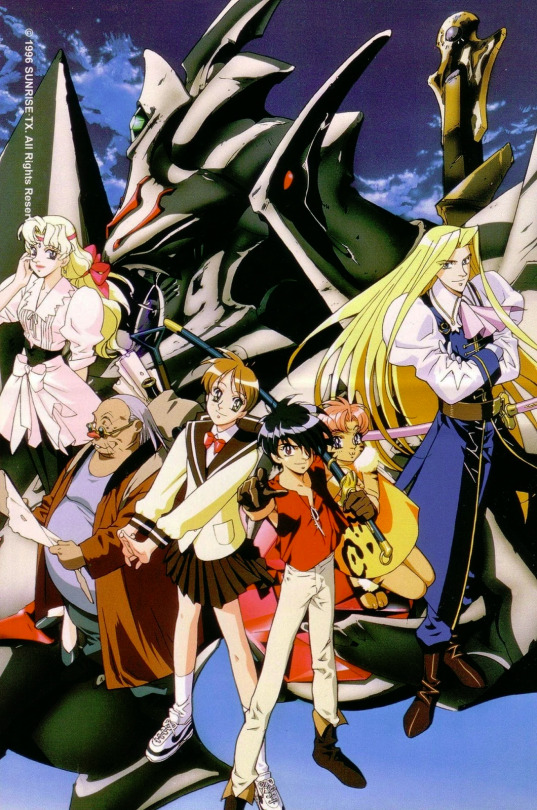
Number of episodes: 26. Language options: dub and subs available. Streaming availability: Funimation.
Produced by Sunrise, this classic 1996 anime is definitely the furthest from the traditional mecha format than any other I’ve watched as of now. Instead of just being mecha with other elements added on, The Vision of Escaflowne is a more or less equal mix of romance, fantasy, and mecha, all of these elements being quite important to its identity. I don’t even know whether it can be classified as a real robot show, like Gundam, a super robot show, like Gurren Lagann, or something else entirely.
Hitomi Kanzaki is an average high school girl whose only real distinguishing traits are an astonishing talent at reading tarot cards and a strange pendant left to her by her grandmother. One day, an attempt from Hitomi to earn her first kiss from her crush on the track team is interrupted by the appearance by the appearance of a pillar of light, out of which comes Van Fanel, a young man with a sword, along with a dragon. After slaying the dragon with some assistance from Hitomi, the pillar of light returns, taking both Hitomi and Van to Gaea, the world from which Van hails from, and where the Earth can be seen in the night sky. Van, as it happens, is the prince of the kingdom of Fanelia, and was assigned to kill a dragon as part of his rite of ascension. Almost immediately after Van’s coronation, however, Fanelia comes under attack by the forces of Zaibach, a highly advanced empire ruled by Emperor Dornkirk, who, using a device that allows him to see into the future, has enacted a plan requiring the devastation of several other countries, Fanelia among them. In the chaos, Van and Hitomi are forced to escape aboard Escaflowne, a special and powerful mech known as a Guymelef that, as Dornkirn soon discovers, is the largest source of uncertainty that stands in the way of Zaibach’s goals. Soon allying with a knight of the kingdom of Asturia known as Allen Schezar, Hitomi and Van set out to discover a way to stop Zaibach and avenge the devastation of Fanelia, pursued by Dilandau, a psychotic commander of Zaibach who leads the elite Dragonslayers, and Folken, a mysterious traitor to Fanelia who answers directly to Dornkirk himself.
The Vision of Escaflowne is just a plain well made series. It has a solid, well developed, and memorable cast, such as Hitomi, who gets to be surprisingly proactive for a character of her kind, and gets several great moments throughout the series, or Dilandau, who manages to be a villain both very entertainingly crazy and surprisingly sympathetic, something he shares with almost the entirety of the other antagonists. The plot moves at a very fast and unique kind of pace, pretty much constantly being on the move, but never feeling exhausting, and has a lot of very neat twists and turns throughout, especially its fascinating take on the concept of fate, as reduced to a scientific concept. One of the writing biggest strengths, however, is the effectiveness of its examination of the horrors of war, which a pretty typical theme for the genre, differentiating itself by focusing a lot on the sheer destruction that is caused by it, and the aftermaths even after individual battles have ended. It also handles fight scenes quite interestingly, as only a handful of episodes really have big dedicated fight sequences, and while they are quite well made and exciting, they’re also often very disturbing, especially the ones in which Van goes on a rampage, something that you would normally be expected find cool. Indeed, the series as a whole has a lot of gruesome and disturbing sequences or elements that just further the nightmarish atmosphere it likes to put on. It’s all very effective, and sends its messages very well.
Moving aside from the writing, The Vision of Escaflowne’s other aspects don’t drop off either. Both the animation and the art direction are quite good, especially where Zaibach’s creations are concerned. The music, composed by Yoko Kanno, best known for Cowboy Bebop, along with Hajime Mizoguchi, is also quite good and effective. I chose to watch Funimation’s 2016 English dub, and overall, I just found it decent. There’s several good performances, such as Caitlin Glass as Hitomi, Aaron Dismuke as Van, and Joel McDonald as Dilandau, but nothing I thought was outstanding. I’ll probably give this a rewatch subbed in the future. All in all, The Vision of Escaflowne is a pretty unique and solid series, handling all its different aspects quite well, and definitely carving out a unique place in the mecha genre for itself. The only reason it’s lower on this list for me is that I just found myself enjoying the others coming up more.
3. The Big O
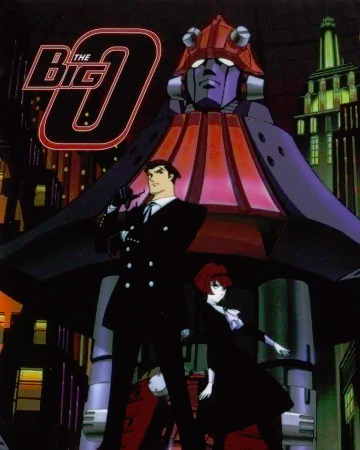
Number of episodes: 26. Language options: dub and subs available. Streaming availability: Hidive (first season only).
Here we have one of the big cult classics of the mecha genre, produced once again by Sunrise. This series has a very interesting history, as it was originally cancelled after its first season, comprising the first thirteen episodes, only to get a revival courtesy of, of all things, Cartoon Network, who helped co-produce the second season a few years later. Unfortunately, to my understanding, this probably turned the series into a bit of a licensing hell, so only the first season is available on Hidive. I did watch the second season as well, though, through other means.
The Big O takes place in Paradigm City, the seeming last bastion of civilization in the world whose inhabitants were all inexplicably and simultaneously struck by amnesia forty years ago, depriving them of their pasts. One of the city’s many inhabitants is Roger Smith, a professional negotiator who, on the surface, is merely hired to help secure deals between parties in conflict or ensure they are carried out smoothly. His jobs, however, often reveal themselves to be far more complicated affairs, forcing him to moonlight as a private investigator and, in the event of serious emergencies, serve as the secret pilot of Big O, a gigantic and immensely powerful “Megadeus”. Working alongside his butler, Norman Burg, R. Dorothy Wayneright, an extremely sophisticated android whose creators were assassinated during one especially convoluted case, and Dan Dastun, Roger’s former commanding officer in the Paradigm City Military Police, Roger finds himself forced to rely on Big O increasingly often, as a string of bizarre incidents involving other megadai begin occurring, many of which appear to be connected to Alex Rosewater, the man in charge of the Paradigm Corporation, and thus the effective ruler of the entire city.
The Big O is a very unique series, to say the least, and one with many strengths. It has a very enjoyable cast, from the stylish and extremely entertaining Roger, to Dorothy, who manages to be one of the more effective and memorable characters of her kind, in my opinion, to Dastun, who gets a very interesting arc across the show dealing with his struggle to actually contribute anything in the face of the megadai, to Schwartzwald, an extremely bombastic and psychotic character who manages to be the show’s coolest and most enjoyable villain by far, with any episode he shows up instantly becoming great. The first season is mostly comprised of monster of the week type plots, with the more dedicated story arc occurring across the second season. The Big O pulls this off better than a lot of other series, however, thanks to just how diverse these monster of the week episodes manage to be, such as an alleged ghost assassinating officials from the military police. The plots to them are crazy, but never jarringly so, instead managing to make the setting of The Big O into one where you can accept just about anything that goes on in it. That doesn’t mean the weirdness of the series doesn’t get jarring, as it definitely ramps up as the series goes on, with the first and last few episodes of season 2 being the most obvious with it, complete with an ending that seems out to defy any attempts to understand it.
Moving onto its other aspects, The Big O is an absolute visual treat, taking heavy inspiration from film noir, giving it a very unique look from almost any other anime series, and its cast taking heavy inspiration from that of Batman. The action scenes are pretty fun and exciting, and the music is very good and very memorable. This is all topped off by a plain great English dub, fitting perfectly with the aesthetics and tone of the series, with Steve Blum as Roger, Lia Sargent as Dorothy, and a magnificently hammy Michael McConnohie as Schwartzwald especially sticking out to me. Overall, The Big O is a fascinating and extremely enjoyable watch. Between its heavy sense of style, great cast, and fascinating story, it definitely earns its reputation as a classic. My opinion on it is only slightly below the next one coming up, and is absolutely worth a watch for anyone curious about it.
2. Mobile Suit Zeta Gundam

Number of episodes: 50. Language options: dub and subs available. Streaming availability: Funimation.
The second full series in the Gundam franchise, produced (shocker) by Sunrise, here we have one of the most important, popular, and influential parts of Gundam as a whole. If not for Zeta’s success after public opinion miraculously granted the original Gundam a much deserved reevaluation, the franchise definitely would have died out, and one of Japan’s biggest media franchises would have never come to be.
In the year 0087, seven years after the end of the One Year War between the Earth Federation and the Principality of Zeon, humanity finds itself deprived of peace once again due to the rise of the Titans, an elite branch of the Federation’s military created to ensure the various space colonies can never form a power like Zeon again. Unfortunately, however, the Titans, unrestrained by the Federation and comprised only on those born on Earth, have become a bullying, oppressive, and elitist force that viciously punishes the colonists for the slightest of reasons. In response to the Titans’ ways, the Anti-Earth Union Group is formed, dedicated to stopping the their abuses and encourage humanity to leave Earth behind entirely in favor of the space colonies. In the middle of all this, Kamille Bidan, a violent, arrogant, hotheaded, and all around troubled teen finds himself in conflict with the Titans, assaulting one of their members, the arrogant rookie Jerid Messa, over an offhanded comment about his name. Managing to escape right as the AEUG is launching an attack on Kamille’s colony, the field base of the Titans, Kamille manages to hijack the Gundam Mk-II, a successor to the original Gundam developed by the Titans, and goes off to join the AEUG and end the tyranny of the Titans.
Compared to the original 1979 Gundam series, which definitely had plenty of rough edges, mostly early on, Zeta Gundam is definitely a much more consistent experience, with many strengths. It has a memorable, complex, and developed cast. Whether it be characters “Quattro Bajeena”, an extremely flimsily disguised Char Aznable, giving a shot at trying to be a decent person and mentor to Kamille after the tribulations of the One Year War, Emma Sheen, a mature and collected Titans officer who quickly deserts upon seeing their corruption, Paptimus Scirocco, a magnificently sinister and manipulative Titans fleet commander who has big plans of his own, or Jerid Messa, Kamille’s almost shockingly sympathetic rival, who undergoes a great deal of character development throughout the series and manages to stand out as one of the most human of the antagonists, there’s plenty of characters to enjoy. Even more minor characters, like Buran, an extremely competent Federation officer who pursues the protagonists for a handful of episodes, manage to leave an impact. The story is even darker than the original series, examining the state of humanity as its central government collapses into apathy in a very interesting way, and most of the goofier super robot elements from the original series, as enjoyable as they could be, are pretty much all done away with, culminating in an infamously depressing ending that hurts even if you’ve heard of it in advance.
The animation is much, much better than that of the original series, allowing for generally much better action scenes, and it has some great designs, both for characters and for mobile suits, and the soundtrack, composed by Shigeaki Saegusa, is much more diverse and memorable than that of the original series, giving the series a pretty epic feel. It’s easy to see why Zeta made an impact, but that said, I do still have a few nitpicks, like the cast as a whole not being quite as classic as that of the original series to me, whether it be Kamille being a much more unlikeable protagonist compared to Amuro, even with him eventually growing out of it, or the Titans generally being much nastier and one dimensional characters compared to many of Zeon’s characters, though several of them still manage to be enjoyable in their own ways, or the tone, which goes for extremely bitter, and doesn’t really do anything to combat it. While it is a large part of the series’ identity, it can get plain exhausting. Still, even if I do prefer some elements of the original Gundam, Zeta Gundam is still a very, very good series otherwise, and my second favorite watch of the franchise so far (the first currently being 0080: War in the Pocket).
1. Eureka Seven

Number of episodes: 50. Language options: dub and subs available. Streaming availability: Funimation.
And now, here we are, the anime that managed to steal my heart more than any other I’ve watched so far and has officially become my new favorite anime not even two weeks after finishing it. For a change, this was produced by Studio Bones, who have officially become one of my most enjoyed studios between this, Fullmetal Alchemist: Brotherhood, and Soul Eater.
Renton Thurston is a young teen stuck living with his grandfather in a dead end city known as Bellforest. Renton’s father, Adroc Thurston, years ago sacrificed his life to save humanity during a near apocalyptic event known as the “Summer of Love”, leaving Renton to be raised by his older sister, who herself mysteriously vanished years ago. Perpetually stuck in his father’s shadow, and with seemingly no possible future besides becoming a mechanic as his grandfather stubbornly insists, Renton’s only escape from his depressing reality is his idolization of Gekkostate, an anti-government group whose counter culture magazine Ray=out fuels Renton’s dreams of becoming a professional lifter, essentially one who surfs through the air. One fateful day, however, the Nirvash typeZERO, a mech known as an LFO that was the very first of its kind, crashes into Renton’s home, in need of repairs. Its pilot is a member of Gekkostate, a mysterious, emotionally reserved girl known as Eureka, whom Renton instantly develops a crush on. Soon, however, the military launches an attack in an attempt to capture the Nirvash and its pilot, and in the confusion, Renton is given the Amita Drive by his grandfather, a strange device created by Adroc that allows the Nirvash to reach its full potential. Soon finding that the Amita Drive only seems to work properly when he’s present, Renton is invited to join Gekkostate by Holland, its leader. Soon after accepting, however, Renton slowly finds his idolization of the group crumbling, as he is constantly denied respect from its other members, particularly Holland, who quickly seems to gain a grudge against the boy. As reality seems determined to go against his expectations and ideals, Renton is forced to question his place in the world and true desires, while, all the while, a sinister plot by the military threatens to bring disastrous consequences upon the world.
The big thing that defines Eureka Seven, the thing that separates it both from the rest of its genre and even many other anime series out there, is the focus it places on Renton and Eureka’s relationship. It isn’t merely more prominent than usual, or even just an important element. It is the core, reason, and appeal of the series, period, one that ties into every other element of the plot and defines the focus and tone of the series from the very start. The result is one of, if not the most endearing, developed, well written, and just plain sweet romances I’ve experienced in any media. The series only improves with every step it takes in developing the two’s relationship, and with it their development as people, and what starts as a silly, one sided crush becomes something so adorably innocent and pure that almost every scene between the two in the second half of the series just had me smiling.
Don’t get me wrong, Eureka Seven is a bit of a slow burn series exactly because of that. Eureka really doesn’t get much focus early on, and the often cruel treatment Renton is initially subjected to can make the earlier episodes a bit of a drag. Eventually, though, it does change, and whether it’s around episode 11, like it was for me, or around the halfway point, like I’m sure it was for others, it reaches a point where it stops playing around and never looks back.
As you may suspect from all that ranting, this relationship is a very, very large part of my emotional attachment to this series, but that’s not nearly the only strength it has. The cast, even beyond the eventually fantastic Renton and Eureka, is one of my favorites out there, with many well developed, complex, and sympathetic characters, whether it be Talho Yuki, the pilot for Gekkostate with a unique understanding of Holland, Dominic Sorel, a young intelligence officer in the military who gradually finds himself unfit for the duties he’s meant to carry out, Anemone, a highly unstable and dangerous girl cared for by Dominic, or Charles and Ray Beams, a very charming couple of mercenaries for hire who are the focus of one of the best arcs in the series, there’s so many characters to love. Even the other, less important members of Gekkostate are very colorful and memorable in their own right, especially considering just how many of them there are. The actual plot, setting, and lore are also very interesting and compelling, taking a lot of fascinating, if confusing, twists and turns the whole way through. It’s also very unapologetically super robot as hell, in a way that reminds me of Gurren Lagann, where the sheer sincerity of it just makes it enjoyable.
Even past the writing, Eurka Seven’s other elements hold up. The look of the series is great, between the animation, the genuinely great character designs, and sleek look of the LFOs. The soundtrack, composed by Naoki Satō, is great and distinctive, and the OPs and EDs are some the catchiest I’ve heard. The English dub is great, with many strong performances, such as Crispin Freeman as Holland, Kate Higgins as Talho, Peter Doyle as Dominic, and Kari Wahlgren as Anemone, though the best performances among them belong to Johnny Yong Bosch as Renton and Stephanie Sheh as Eureka, in what I think are definitely some of their best performances out there. That said, I definitely plan to rewatch this series subbed someday, just out of pure curiosity.
All in all, Eureka Seven is a fantastic watch, one I can’t recommend enough. It’s a unique, emotional, and all around very memorable experience, one that’s so warm and positive that it actually just made me feel good and refreshed watching it. It doesn’t go overboard with it, as there’s plenty of depressing or creepy parts throughout, and it deals with some dark subjects throughout. It’s through refusing to push these elements aside and still managing to keep the emotional core of the series intact it manages to work so well. Even as someone who rarely rewatches anything, especially not longer series, this is definitely one I’m going to revisit a few times, if only for the sake of getting friends to watch it.
And with that, this post finally draws to a close. For once, this is a case where I’d recommend every series on this list. I definitely need a bit of a break from anything mecha for now, but there’s still plenty of other series out there that I plan to give a watch eventually, especially within the Gundam franchise. Till next time.
-Scout
#anime#eureka seven#gundam#the big o#the vision of escaflowne#mobile suit zeta gundam#mobile suit gundam zz#mecha
24 notes
·
View notes
Note
has your reviews and stuff gotten you a nice follower account
Not especially, and I'm not sure how many of them even care about what I put out, but I still value each and every one of them.
1 note
·
View note
Note
Favorite character ever?
I knew whatever my first ask was would go straight for the throat. Anyway, Kurisu Makise from Steins;Gate.
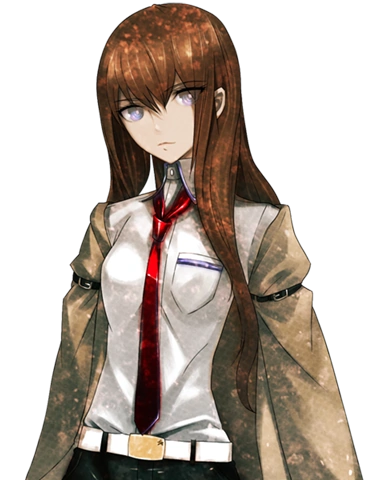
Just a superbly written and fleshed out character. Always entertaining, very sympathetic and understandable, possibly more so than any other tsundere out there, and has an S+ tier design on top of that. Just the kind of character I can't get enough of.
7 notes
·
View notes
Text
AMAs
AMAs are open for me, by the way. Technically they’ve been open all this time, but I’m (finally) trying to move away from being so rigid on what kinds of posts I put out, so may as well officially announce it now. So for any who care, feel free to send an ask my way.
1 note
·
View note
Text
One of the funniest things in anime to me is when the OPs, and to a lesser extent, the EDs, are just completely unfitting in tone compared to the episodes they play around. Stuff like Mobile Suit Zeta Gundam’s super peppy ED, which never changes even when the OP becomes more melancholy and the show takes a nosedive into pure depression, or whatever the hell Attack on Titan’s season 3 part 1 OP is.
I think my favorite example that I’ve seen is Eureka Seven’s second OP and ED. They’re super upbeat and catchy, and would be totally fitting for the series normally, but the part they play over is just a string of the most depressing, angsty, and all around miserable episodes in the whole series. If they played at any other point, you wouldn’t think twice about it, but instead it’s like two slaps in the face every episode. They’re still great songs, though.
15 notes
·
View notes
Text
I finished Eureka Seven last night, and holy shit, that easily became one of my top 3 favorite anime before I was even completely finished with it. Easily one of the most endearing and well developed love stories I’ve ever experienced. Literally the only bad thing I can say about it is that it took me till about episode 9 to really start getting invested, but for a longer series, that’s perfectly fine. Besides that, the music was really great and memorable, even for someone who rarely notices music in anime like me, the story, setting, and lore were really interesting, and the cast is just fantastic and super well developed (Renton and Eureka are definitely some of my favorite protagonists/deuteragonists out there now, and I just loved Dominic, Anemone, Charles, and Ray too, for just some examples), and altogether make for one of my favorite casts out there.
More than anything, though, it’s just so, so sweet. So many little moments between Renton and Eureka got me smiling, and having it be a rare relationship in anime where it isn’t just stuck waiting for the ending to truly go anywhere, but one that evolves constantly throughout the series, even going far past just the initiation, is something I enjoyed a ton. I just really got emotionally invested in this series in a way I don’t often do, and plenty moments got me tearing up or even crying a bit, which is still not as common for me as I’d prefer. All of this plus the unflinching idealism just made it feel really good to watch. It made me feel refreshed and upbeat about it in a way I haven’t felt in too long. It’s like the definition of a feel-good anime. The journey isn’t always pretty: sometimes it’s frustrating, sometimes it’s freaky, sometimes it’s just plain sad, but the emotional core to it all is just so warm that it’s worth it all. Seriously, whether you’re a mecha fan, a love story fan, or just someone who wants a unique kind of series to break things up, I can’t recommend Eureka Seven enough now. It might take longer than it did for me to get into, but the end result is absolutely worth the time.
62 notes
·
View notes
Text
Digital Devil Story: Megami Tensei II re-review
It’s not uncommon at all for the very first game in a long running video game series to have significant differences from its later installments. Later sequels already have a foundation to work with, and thus have more room to simply focus on adding new features and mechanics, or simply polishing existing ones, meaning that many mechanics and quality of life features that often become very familiar to players and may well be essential to the identity of a series only originated from a sequel. This is the case with Shin Megami Tensei, to an even larger degree than some other series. If one were to ask me where SMT truly began, I would answer with Megami Tensei II, the sequel to the very first SMT game, Megami Tensei, and the predecessor to the proper Shin Megami Tensei I that would be released on the SNES. Along with many mechanics and improvements, Megami Tensei II also brought the series forward in areas like setting, story, and aesthetics. This is honestly a fascinating game to me, and thus, I’d like to take a second look through it, with a re-review similar to what I wrote last time on Megami Tensei I. Before we start though, I’m not going to focus much on core mechanics that already appeared in my MT1 review, which can be found here, and secondly, there will be full game spoilers, for anyone who cares about that. Anyway, with that said, let’s get to it. As with MT1, I played the SNES remake, Kyuuyaku Megami Tensei.

Story:
In the year 199X, humanity was devastated by a nuclear war that destroyed civilization and opened a passage between the human world and the Expanse, leading to demonic hordes quickly conquering the remains of the world and oppressing what was left of humanity. Tokyo in particular was directly hit by a missile, with the demon lord Bael soon establishing dominion over the surface, forcing the survivors to take refuge in the ruins of Tokyo’s wards, or, for the fortunate, in shelters that offer those who live in them safe and comfortable lives. 35 years later, two young residents of one of these shelters, Takuma and Ryu (two characters who are nameable in game and lack default names, but will be referred to by the names given to them in the gamebook Messiah Project 2036), accidentally release a demon called Pazuzu while playing a mysterious video game known as Devil Busters. Pazuzu, who claims to be God’s messenger, declares the two to be the Messiahs who will free humanity from the rule of the demons. In order to aid them in accomplishing this, Pazuzu gifts Takuma with a COMP, a portable device that allows its user to communicate with and summon demons, and grants Ryu the ability to use magic, afterwards guiding them to meet up with one of his servants, Orthrus, and instructing to the duo to kill a witch named Asuka (another nameable character) who betrayed Pazuzu.

Upon confronting Asuka, however, she explains that she believes that Pazuzu merely wishes to replace Bael as ruler of Tokyo, and is using the “Messiahs” in order to accomplish this. While Takuma agrees with her assessment, Ryu, having grown accustomed to the praise and sense of duty that acting as a Messiah has granted him, sides with Pazuzu and abandons the two. Teaming up with Asuka in order to properly free Tokyo from the rule of the demons, Takuma begins to journey through the ruins of Tokyo’s wards, collecting the Seven Pillars of Solomon along the way, artifacts that, when placed at the center of the nuclear missile’s impact, will grant access to the Expanse, and allow the two to take the fight to its demonic rulers, led by Lucifer, formerly imprisoned in ice after his battle with Nakajima, only to be freed by Ryu.

Immediately, Megami Tensei II’s plot is an improvement over the first game’s plot. Most prominently, it establishes the post apocalyptic setting that would become common for the series. That said, for the most part, there still isn’t much plot to be found, as most of what happens are unrelated, fairly random events scattered across all the different locations visited, such as dealing with cults consisting of humans brainwashed by demons, a living island swallowing the protagonists and forcing them to traverse its insides, and even Takuma getting his left arm bitten off by a trap guarding one of the pillars, forcing him to get a cybernetic replacement. Yeah. This is genuinely one of the weirdest games I’ve ever played. There’s also not much really tying it together with the plot of the first game, besides a few references. That said, it does get a bit more interesting towards the end, assuming one is on the path to the good ending, which is where we enter full spoiler territory.
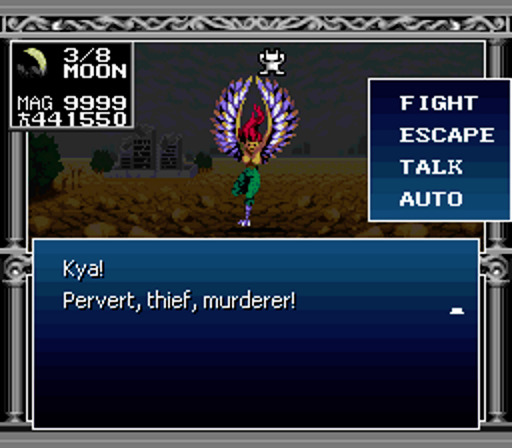
Upon defeating Bael, he turns into a frog that Takuma is able to take with him, and upon confronting Beelzebub, Lucifer’s right hand man, with the frog along, Beelzebub reveals that he and Bael were once the Canaanite god Baal, split in two by none other YHVH/God. After allowing them to return to their original form and traveling through Lucifer’s temple, Lucifer further reveals that YHVH had demonized all other gods in order to ensure uncontested rule over humanity, and that Lucifer himself was an angel cast out of Heaven for giving humanity the gift of wisdom, with humanity proceeding to worship Lucifer himself in the hopes of gaining even more knowledge. In anger, YHVH instructed Satan, his servant and a former ally of Lucifer, to cause the nuclear war and eradicate humanity. Allying with Takuma in order to defeat Satan, they afterwards take the fight to YHVH himself in order to rid the world of demons and ensure humanity’s survival.
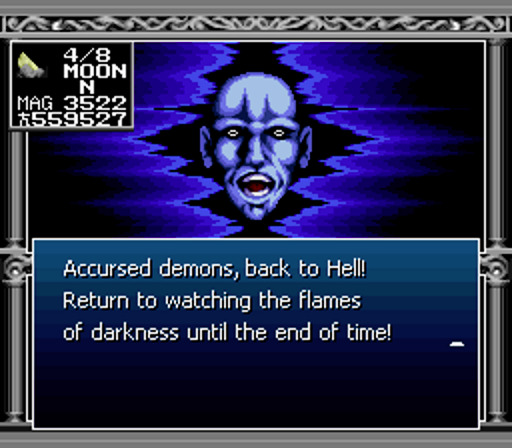
Yes, this game let you fight God before even SMT2 did. In one move, this establishes the central conflict of Law vs. Chaos that would become so important to the series, YHVH’s dethroning and demonization of other deities, establishes Satan as YHVH’s right hand, and Lucifer’s commitment to fighting YHVH above all else. It’s also the introduction of multiple endings to the series, as you can either betray Lucifer at the last moment and join with YHVH, or never even properly ally with Lucifer by instead killing the frog, refusing to fuse Bael and Beelzebub together, or denying Lucifer’s offer of alliance, which instead gives you a bad ending where YHVH gives Takuma and Asuka a home in the Millennium Kingdom, turning the two into gods. That said, it’s all still not as developed as in later games. YHVH is just focused on eradicating humanity outright, the very involvement of the Law faction is kept secret until very late in the game, Satan is just a smug, malicious sycophant lacking any depth, and Lucifer is portrayed as a straight up good guy, rather than being just as dangerous as YHVH. Still, it’s incredible just how many series traditions were added here, and even if the end result is still lacking, I can’t help but appreciate it.
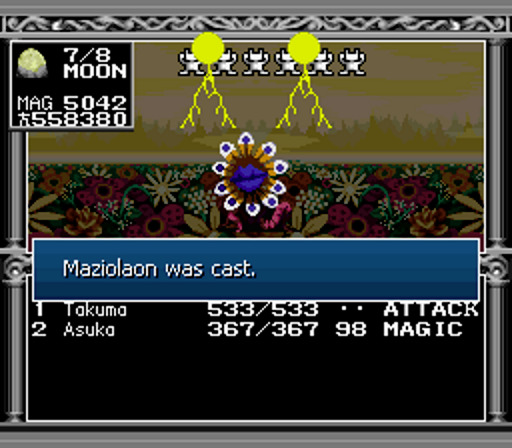
Gameplay:
The basic gameplay of Megami Tensei II is mostly the same as the first game, so I won’t reiterate too many points from there. Probably the biggest addition is that, instead of taking place in one gigantic labyrinth with multiple areas, there’s now an overworld map that allows you to explore the surface of Tokyo and travel to different individual towns or other areas. You can still encounter enemies on the overworld, and in fact the encounter rate for it seems even higher for it than normal, but magnetite isn’t drained even while you have demons out, which makes it much easier to get from place to place. This overworld does a lot to help the pacing, as there’s now many more locations to visit, meaning dungeons are much, much shorter than in the first game. In addition, instead of saving the game at village elders, terminals have been added, which perform the same function, but also allow you to teleport between them, making it so much easier to backtrack or get to different areas if, for instance, you’re looking for specific demons to use for fusion. Buildings and other areas within towns will still have random encounters if they’re explorable, but it’s still not too bad to deal with.
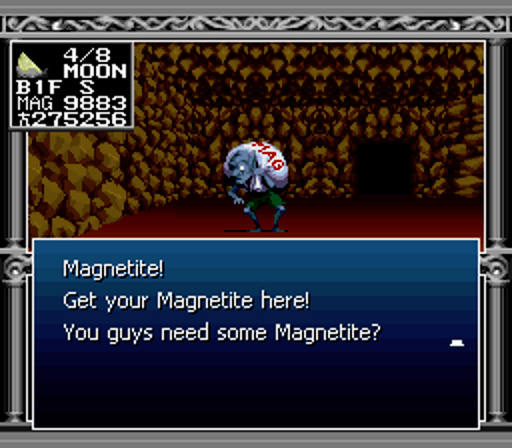
Combat isn’t too different, but there have been some additions. Most notably, guns are now a separate weapon for the humans to use, though unfortunately they’re pretty underutilized. They’re more effective against enemies made of flesh and blood, with melee weapons being more effective against enemies with thin or intangible bodies instead, and in the early parts of the game, this dynamic holds up. Later on, however, guns drop in effectiveness pretty hard, and while they do generally still hit more enemies per round than melee weapons, you’ll soon find yourself switching to melee full time. On that subject, shops no longer sell melee weapons, instead only selling guns and armor, leaving melee weapons to only be dropped by enemies, which is a system that honestly just frustrates me. Luck now apparently increases drop rates from enemies, but on average, it seems to be pretty rare for them to drop anything, which is pretty terrible when you can’t even find weapons in treasure chests, with only three weapons total being given through events, all of which are near the end of the game.
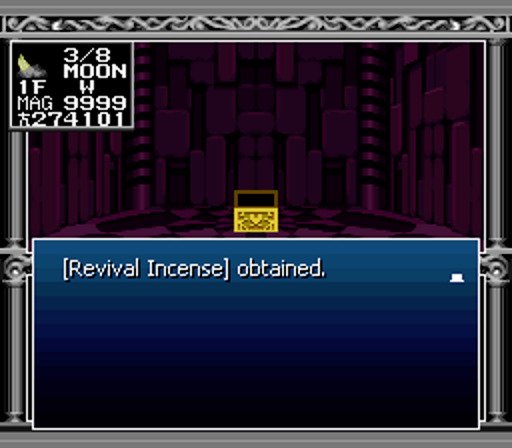
Armor now does more than just increasing defense, and different categories of it give boosts to one’s stats. Helmets typically increase intellect, gloves increase strength and occasionally vitality, boots increase speed and occasionally strength, and capes, a new category of armor, increase luck, with these boosts applying even if they go past the natural stat cap of 35. Some pieces of armor also give resistance to certain elements, further increasing the protection they give. This is all great, but it’s contrasted by a horrible, horrible increase in price. Money is already pretty tight in this, what with needing it to summon demons in the first place and pay for healers, and equipment is so expensive that it actually feels like you aren’t even expected to get more than a few pieces across the whole game. Even abusing casinos, which are more common than in the first game, and the sole source of capes, at that, every new shop you come across will quickly drain you of everything you earned. I really don’t understand what they were trying to do with this, but when you price equipment for over 100,000 macca by the end of the game, when enemies barely drop anything and even casinos will only earn you about half of that per round, you’ve screwed up somewhere. There’s also a few pieces of equipment, namely Lucifer’s armor, the best armor in the game, and Lucifer’s sword, one of the best swords in the game, that actually have stat requirements, with Takuma needing 20 base intellect to equip Lucifer’s sword, and needing 30 vitality and 25 intellect to equip Lucifer’s armor, though stat boosts do count in this case, saving you at best 2 points of vitality and 4 points of intellect with the best gloves and second best helmet. If you know about it in advance, it actually gives a nice incentive to level intellect on Takuma, since it might otherwise seem pretty pointless if one doesn’t know about its effects, but considering these are given at the end of the game, someone playing blind will find these pretty nasty surprises

In terms of other improvements when it comes to combat, spells have been added and even overhauled a bit. Buff and debuff spells are more common than in the first game, and they do have a noticeable effect as long as you cast them twice, and demons overall generally come with a nice spread of supportive spells to help make your life a bit easier. Asuka’s selection of spells is pretty different from Yumiko’s from the first game, learning Zio spells instead of Agi spells, which is much more useful, and learning Traesto and Tranpa, letting her teleport the party out of dungeons and teleport back to the last used terminal respectively, making getting around even easier. Incenses, the stat boosting items in SMT, have also been added, with 5 total incenses for vitality, intellect, and strength, 4 for speed, and 6 for luck scattered throughout, less than in later games, but still enough to give some nice boosts. There’s many more bosses than in the first game, all of which give pretty great amounts of EXP and help spice things up just a bit, and some even belong to optional side areas. There’s also a proper tutorial, in the form of the Devil Busters game, which introduces overworld movement, demon recruitment, and gives actual explanations about many mechanics, such as moon phases, fusion, magnetite, and what stats actually do. Additionally, there’s no negative consequences for dying in Devil Busters, so you can just continue afterwards. It’s a much kinder introduction than one would expect, and it’s extra neat to play because it’s actually based off the Tower of Daedalus, the first dungeon in MT1, down to the music.

However, the most interesting additions and changes are those made to the demons. As before, they’re still only sorted into evil, neutral, and good demons, with neutral demons being recruitable from random encounters and good demons being fusion only, but the amount of them has been expanded pretty nicely. The first game only had 142 demons total, with 65 of them being neutral or good. MT2, on the other hand, has 250 demons, with 121 of them being evil, 64 being neutral, and 65 being good, meaning there’s actually a few more useable demons than enemy only ones. Obviously, this increases the scope of it drastically, and ensures that almost every level Takuma gains opens up another demon or two to use. Demons also have much more focused stat lines, with many of them focusing on stats like vitality and strength at the expense of speed and intellect, for instance, which theoretically makes them more focused than the very balanced stats that good demons in MT1 would have by the end. Unfortunately, this actually just hurts the viability of many of them, especially those with low intellect, as many bosses in the Expanse and endgame have very damaging spells that will wreck anything without high intellect. There’s also several demons that can be acquired through events, with them often being unique and usable regardless of level, which is very helpful.
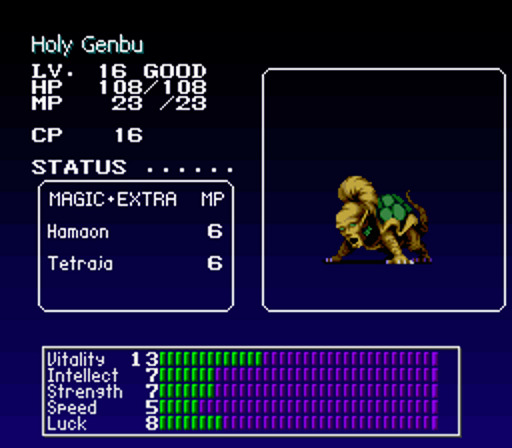
The mechanic related to demons that was overhauled the most, however, is fusion. Most importantly, instead of needing very specific demons to get specific results, like in MT1, the much more familiar formula of the races of the demons used plus the average of their levels determining the result is introduced, with the result always rounding up if it isn’t exact. This system is much more forgiving and easy to use than the first game, and it’s made even better through the proper introduction of elements, who, when fused with certain races, will always make the result the next highest demon in that race. For instance, fusing Salamander with an Avatar demon will always result in the Avatar above the Avatar used. Since demons still don’t level up, and there’s no skill inheritance, there’s no downsides to using elements, so you can keep your demons upgraded throughout the game pretty easily, if still tediously. The only races that can’t be upgraded through this method are the Fairy, Element, Divine, and Deity races.
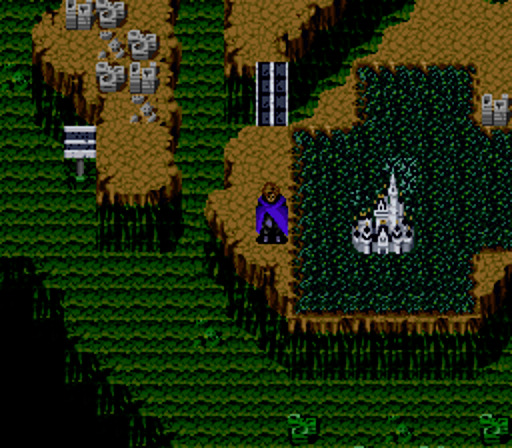
Also introduced is triple fusion and special fusion. Triple fusion can only be performed with good demons, and obviously uses three demons at once, compared to the normal double fusion, which uses two. Special fusion deviates from the normal formulas and produces special results when fusing specific demons together. These aren’t too important usually, but the Kishins Zouchouten, Koumokuten, Jikokuten, and Tamonten can be made through special triple fusion in addition their normally much harder requirements, Divines can only be made through triple or special fusion, and Deities can only be made through triple fusion, with the ultimate fusion demon, Shiva, only being obtainable through triple fusion using some of the strongest demons in the game.
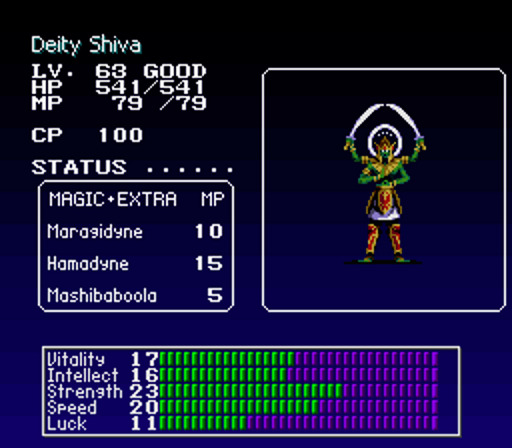
While most of this is much better designed than in the first game, there is one bizarre series of occurrences that I really need to go on a tangent about, that being everything to do with the Divine race. Consisting of Uriel, Raphael, Cherubim, Nike, Gabriel, and Michael, as stated above, they can only be acquired through triple or special fusion, though in actuality, Cherub and Nike seem to be the only ones acquirable through normal triple fusion, and even then, only if you’re clever. The archangels all require special triple fusion with elements, Cherub otherwise requires a fusion of Sword Knight, a one time event demon, and Sylph, and Nike requires Valkyrie fused with Ocypete, Aello, or Celaeno. The problem with all this is that, by the time you can do most of this, they are horrendously outclassed. Uriel and Raphael, level 13 and 20 respectively, both require Salamander, a level 38 element, Sword Knight is far better than the level 27 Cherubim, and Valkyrie is level 57 and only appears in the second to last dungeon in the game, at a time when the level 35 Nike has long lost its uses. Most of these mentions demons have poor stats even for their levels, and the only real advantage they have is Samarecarm, a resurrection spell that is worth far less than the developers seem to have thought. Gabriel and Michael are actually quite good, with Michael in particular being viable even to the end of the game, and are much easier to acquire, which really makes me wonder what the devs were thinking with the rest of this race.

In one finally note in regards to the gameplay, there’s actually a fair amount of easter eggs that can be accessed in the SNES version of this game, with most of them only being accessible if one played through MT1 first and did certain actions there. These range from Izanami giving you a robe that allows you to safely cross damage tiles if you gave her silk thread in MT1, being able to acquire a restorative item from Rag’s shop if you entered it at least twice in MT1, which combined with a piece of equipment you can win at casinos, allows you to acquire Qing Long, Bai Long, and Kali, three endgame demons, for free at any Cathedral of Shadows, to, most prominently, gaining access to three small bonus areas if Bael is killed as a frog, wherein you can find Artemis, Leto, and Apollo, three demons exclusive to this version who can then be specially fused to make Zeus, who has a hilariously bizarre design in this game. It’s pretty cool, but all these exclusive demons, Zeus included, are just copies of other demons statwise, most of which are acquirable through the good ending route for free, and since you have to lock yourself into the bad ending to access any of this, it’s a novelty at best.

Overall, the gameplay of MT2 is much more refined than its predecessor. The improvements to fusion and the addition of the overworld alone helps the pace a ton, and makes for a much more fun game. That doesn’t mean it doesn’t have moments of bad design, as the encounter rate actually feels even higher than in the first game, and the Expanse has some miserable areas, mainly the Forest of Confusion, which contains several caves the COMP doesn’t work, preventing you from summoning demons within them or even using the automap, and also contains Astaroth’s castle, which starts with Asuka being kidnapped, forcing you to trudge through the entire dungeon and fight Astaroth himself without your dedicated healer. It’s horrible, needless to say. All the same, though, I did have some amount of fun with this game’s gameplay, which is more than I can say about MT1.
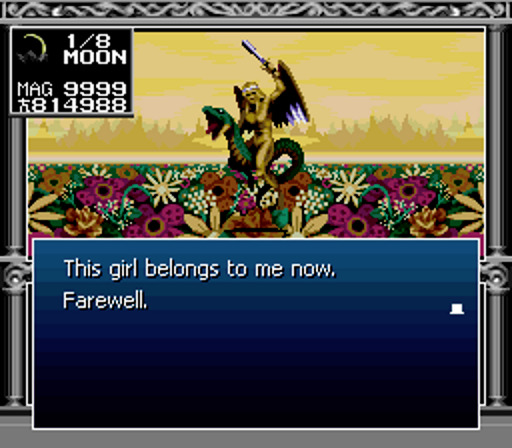
Graphics:
The visuals of MT2 are actually a good improvement over MT1. It still has the same bland, repetitive dungeons, but the overworld is actually pretty neat to look at, giving the main character a pretty cool looking sprite, and both Tokyo and the Expanse look properly gruesome to explore. As for the demons, the visual highlights of most SMT games, they’ve been improved as well, courtesy of Kazuma Kaneko, the series main artist, actually working on this game, unlike MT1. This means many demons now have much better looking designs, with many of them looking plain cool, and compared to MT1, which had many, many of its sprites changed for the SNES version, MT2′s SNES sprites are much closer to their original versions. Many demons, such as Lucifer, YHVH, Astaroth, Barong, and Girimehkala have designs pretty close to their later, more iconic ones, and so many iconic demons were introduced in this. In addition to the above mentioned ones like Shiva and the Archangels, Pixie, Vishnu, Pyro Jack, and even Jack Frost himself first debuted here. That said, several designs, like Beelzebub and Satan, are much more different, and there’s still plenty of weird demons, like man eating plants, several directly based on the Coin, Wand, Cup, and Sword minor arcanas, and even several possessed humans, based on heavy metal fans and Jason Voorhees. I’m not kidding. Still, it’s a significant step forward, and makes for some cool enemies to fight.

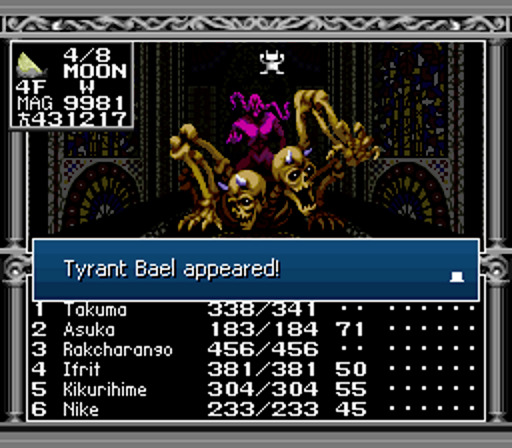
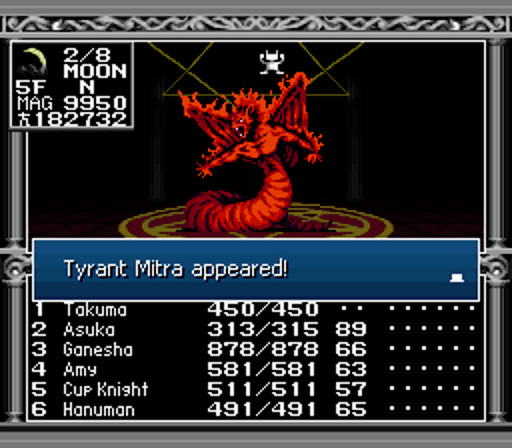

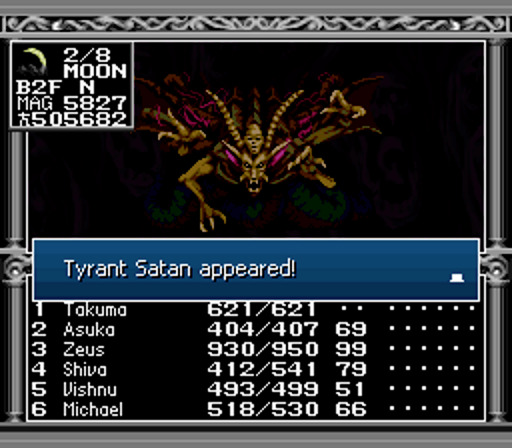
Music:
The soundtrack to MT2 is also an improvement over MT1, which already had a decent soundtrack. The main reason for this is that the cartridges used memory mappers that included extra sound hardware, resulting in the original Famicom version of MT2 having one of the richest 8-bit soundtracks ever, courtesy of Tsukasa Masuko, a soundtrack which was very faithfully remixed for this SNES version. From the rocking battle theme Death Match, to Explorer, the theme for exploring buildings in Tokyo, to the overworld theme for the Expanse, Hallucination, and especially OMEGA, the boss themes for Satan and YHVH that even has different mixes for both of them, it’s a joy of a soundtrack to listen to, and it’s worth a listen even if the game itself is unappealing to you.

Conclusion:
Overall, Megami Tensei II is unfortunately still not a game I can recommend. It’s a big improvement, absolutely, and I’d even say it’s up there with Dragon Quest III, Dragon Quest IV, Final Fantasy III, and MOTHER in terms of the best designed Famicom/NES RPGs. However, best designed is only relative. It’s still grindy, frustrating, obtuse, and cheap as hell. It’s much more playable than Megami Tensei I, but still undoubtedly more than most would be able to handle. That said, if you’re really, really interested in the very beginnings of SMT, this is worth a look, at least. It properly set down the foundation for one of the biggest RPG franchises today, and it’s still impressive to see how much it did.
With that, we’re finally done here. With my replays of these two relics out of the way, I can finally move into new territory with this series, and I’m quite excited to do so. I can actually say with confidence I’ll be playing a lot of SMT this year. Till next time.
-Scout
10 notes
·
View notes